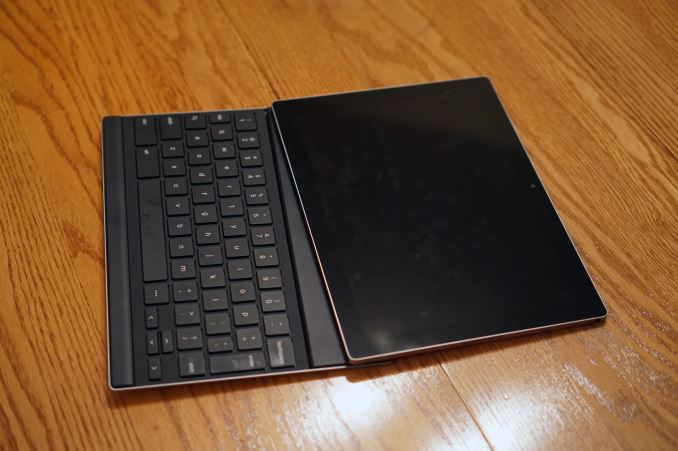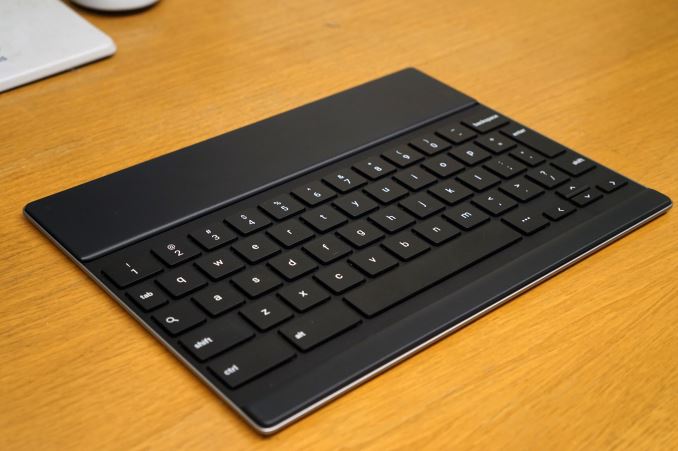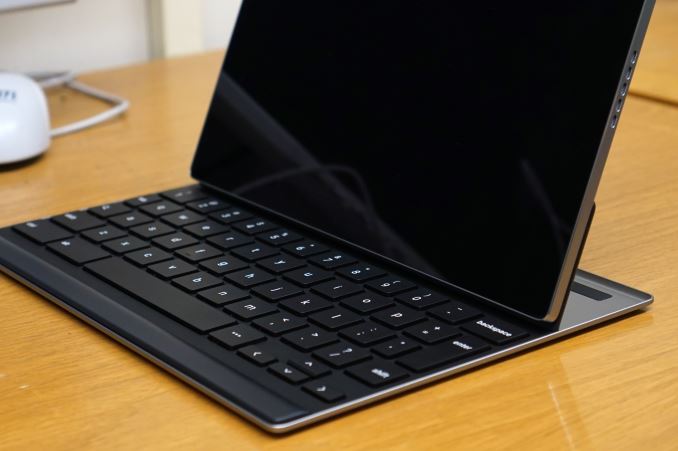The Google Pixel C Review
by Brandon Chester & Joshua Ho on January 25, 2016 8:00 AM ESTKeyboard
Part of the Pixel C’s appeal comes from the keyboard accessory. It isn’t included with the tablet itself, but this is true of most keyboards on tablets so it’s not as if the Pixel C is behind the competition in this regard. At $149 the keyboard is also well priced for one made out of machined aluminum, with full key travel and the Pixel C’s signature magnetic hinge.
Before talking about the keyboard itself, it’s probably a good idea to go over how that magnetic hinge works. The back of the Pixel C’s keyboard is a large aluminum flap with an equally large magnet on top. The best way you could describe the system is that this flap is connected to a very stiff hinge, which allows the flap to go to almost any angle up to about 85 degrees from the horizontal. The tablet has magnets embedded in its back which allow it to connect to this flap, and there’s enough strength in the connection to keep the tablet connected, as well as enough strength holding up the flap to prevent the mass of the tablet from causing it to start shifting back to a horizontal position. This system allows Google to give very fine angle adjustments without having to embed a kickstand in the Pixel C, and it’s quite a clever solution to the problem.
Of course, a unique keyboard solution does come with unique challenges. Obviously you end up with less space for the keyboard because the entire piece has to be the same size as the tablet, with a significant portion being dedicated to the magnetic flap. This is just an inherent result of the design, and while one could say it’s a waste, I would argue that the benefits of the system far outweigh this apparent downside.
The only real problem is training yourself to use the system correctly. When you put the tablet and keyboard together, you need to orient it with the tablet’s LED light bar on the same side as the keyboard’s space bar, or the keyboard won’t be able to charge using the Pixel C’s inductive charging. Unfortunately, this leads to some moments of confusion as you try to orient the tablet correctly after removing it. To split apart the keyboard and tablet Google recommends that you slide the two apart by pushing on the shorter sides of the keyboard and tablet. The first issue with this approach is that anything trapped between the keyboard and display is liable to absolutely ruin the glass, which has happened to my unit around some corners of the display.
The other issue is that once the two are separated you then need to remember to flip the tablet upward to put it in the right position to connect with the keyboard. While this seems like a natural motion, I find myself doing it incorrectly because even after sliding the two sections apart there’s still a magnetic attraction between the long edges of the tablet and keyboard, which causes me to favor rotating the tablet in order to separate them. In this case, the tablet ends up being upside down, and so you need to look at it and orient it such that the front-facing camera is on the top bezel before attaching it to the keyboard.
While some may feel that my issues working out the connection and disconnection of the keyboard are simply user error, it is worth noting that Google includes an enormous instruction sheet along with the Pixel C, and so confusion among users is clearly expected to some extent. I’ve gotten better at setting up the tablet in keyboard mode quickly, but it’s still not an action that has become a second nature to me.
Once you’ve set up the keyboard, you may notice something very familiar about it if you’ve had any experience with Google’s other Pixel products. The core part of the keyboard uses the exact same key size, pitch, and travel distance as the Chromebook Pixel. Google has shrunken the keys around the edges in order to match the keyboard to the Pixel C’s 10.2” display, but I haven’t found it to be much of a problem in use. On the contrary, I think the feel of the keyboard is great. The keys have a good tactile response, and the spacing is comfortable. In my eyes it definitely surpasses the iPad Pro’s Smart Keyboard by a large margin, although I’m not sure how well it compares to Microsoft’s Surface Type Cover.
Unfortunately, the keyboard becomes another area where the apparent mid-development switch to Android causes numerous issues. On the design side, you’ll notice that the keyboard follows the Chromebook Pixel in replacing the caps lock key with a search button. Right off the bat, I noticed a glaring issue with the implementation of this key. You can press search to open a search box anywhere, but I cannot find any way to close the search box if you open it by accident. If you open the search field you need to tap on the display to close it. There needs to be forgiveness in the design, either by making a backspace press when the field is empty close it, or by allowing you to close it by tapping search again with an empty field.
Android itself just doesn’t work very well with keyboards either. In fact, this implementation isn’t near as good as what I saw on the Dell Venue 10, and I didn’t think that provided a very good experience either. The big problem stems from the fact that Google hasn’t included proper navigation keys, which is more evidence that this device wasn’t ever meant to run Android in the first place. The omission of keys to trigger the standard home, back, and recent apps buttons is simply unacceptable. Google does have a help page online which lets you know the cryptic multiple key combos that perform these actions, but I don’t understand why a simple action like home needs to be activated by pressing search and enter, which are on entirely different sides of the keyboard. The same is true of back, which is search + backspace. Thankfully, Google does offer standard shortcuts in many of their apps, but the lack of navigational buttons on the keyboard is a big problem.
Ultimately, the Pixel C’s keyboard is a great piece of hardware, but Android doesn’t work very well with keyboards, and this keyboard in particular is ill suited to Android on top of that. Google has a very novel hinge implementation, and the inductive charging takes away the need to charge the keyboard, but many of the processes need to be streamlined and just generally made easier for the user to understand and get used to quickly. The tablet really needs to be able to attach onto and charge the keyboard without requiring a specific orientation, and the keyboard needs proper Android navigation shortcuts on top of Android simply needing much better keyboard support and applications to take advantage of one. I would love to see the ideas behind the Pixel C’s keyboard and hinge make it into keyboards from other manufacturers in the future, as well as future Android tablets that better deliver on promises of productivity abilities.














122 Comments
View All Comments
Laxaa - Tuesday, January 26, 2016 - link
It seems to me like the Pixel C was released a year or two too early.versesuvius - Tuesday, January 26, 2016 - link
Adding a keyboard to an ARM device is just adding insult to injury. ARM devices are never going to be useful beyond what they were intended to be in the first instance, which is content consuming devices. Their advantage, which is size and power consumption, is also their limitation. If any company tries to sell an ARM device with a keyboard, one can be pretty sure that that company is pretty much at the end of the road. Disabling four cores of the processor on the top device from the company, while pushing a keyboard on buyers, just says it all. It says that the buyer was not going to do anything useful with it anyway, that is with this device from this particular company anyway.hMunster - Tuesday, January 26, 2016 - link
How can you appload the battery run time and lament the size and weight at the same time?10basetom - Tuesday, January 26, 2016 - link
So the final grade for the Pixel C is a C. Final grade for Android tablet ecosystem? D-Lolimaster - Tuesday, January 26, 2016 - link
How can you release a tablet without SD reader, come on.This tablet would be perfect for reading my collection comics&manga, I don't want to rely on the internetz just for reading purposes.
Demigod79 - Tuesday, January 26, 2016 - link
A couple of years ago I attached a keyboard case to a Nexus 10 and tried to use it like a laptop. It failed. Even though the Nexus 10 supported keyboard navigation and mouse input I found it difficult to anything really productive, and having a keyboard cover on it limited its functionality as a tablet. The Pixel C seems to be a modern-day rehash of my failed experiment with the Nexus 10 and I can very well imagine how using it would be (that is, very bad).The thing is, I had thought Android tablets would gradually evolve and grow, incorporating desktop features like expanded storage and windows apps. The latter was something that I particularly desired ever since using Samsung tablets that had pop-up apps. I thought this was the future and hoped Google would adopt and expand it to incorporate all apps. Frankly, I never thought tablets should have tablet versions of apps. In my opinion, running one app at a time was largely due to the limited screen space available on a phone, which obviously didn't apply to tablets. I thought the natural thing to do with a tablet was to run those phone apps in separate windows, not have bigger versions of those apps. I dreamed of the day when I would be able to run multiple Android apps at once like I did on my laptop.
I waited in vain for Google to incorporate windows apps, and then last year I got fed up and bought a Surface Pro 4 instead. It was the best decision I had ever made. Not only can the Surface Pro 4 replace my laptop (haven't touched it since) it can also replace my tablet since I can run Bluestacks (Android emulator) on it. Best of all, I can finally run Android apps in a window like I've always wanted to do. Add in the ability to run desktop applications as well as desktop games through Steam and it easily ranks as the best mobile device I've ever bought. I have given up on Microsoft for a while but it now seems to be the future (Android had the potential to be the future but Google squandered the opportunity, and now they are relegated to creating lame products like the Pixel C).
deppman - Friday, January 29, 2016 - link
I agree, although I prefer Ubuntu as my general purpose OS since it is more appropriate for my needs.Have you seen Jive's Remix OS? It's pretty much what you describe, and it's run by ex googlers. I expect Google to buy them out because the evolution is so obvious and correct. It's my guess that internal political BS is what has happened here. If they simply added windowed ART apps to chrome OS - or windowed apps and a full chrome browser build to android, they'd achieve pretty much what you described.
IMO, they are missing a wonderful opportunity to unseat MS as the primary desktop OS by not resolving this obvious elephant in the room.
Nisthar - Wednesday, January 27, 2016 - link
Hi Guys, This is a contest hosted by one of the members in my site. He needs a review on Lenovo k4 note + AntVR headset. You can view the contest http://reviewill.com/contest/2 . You may need to register to apply for the contest. The requirements for the contest would be mentioned in the contest description written by him. The winner will recieve $150.Ways to earn money in the site:
1. You can earn through referring your friends. You will get $1 for every 10 users that you refer. The referrals should be verified.
2. You can earn big money through cpa offers.
3. You can post interesting stories through quickpost.
4. You can get 100% user written custom reviews on any brands, companies, movies, etc.
Sign up: http://reviewill.com/register
Sorry if it disturbed you :)
alexlaoe - Wednesday, January 27, 2016 - link
Runs very well. Just bought one and I love the beauty behind the design.https://open.spotify.com/user/artistm/playlist/1RC...
Rc1138 - Sunday, January 31, 2016 - link
Despite my love for big tablets I can't bring myself to like this device. Making a "productivity" tablet is just too early for android. I have a really old nexus 10 and it's nand perfomance as well as overall stability(touch,wi-fi and apps) is several times better than this halfassed powerhouse. The only thing I like about Pixel C is battery perfomance(both battery life and charge time) because nexus 10's charge time equals it's web browsing time(roughly 7 hours). I can't think of a targeted group this tablet is aimed for because for the same price you can buy a really sophisticated surface 3